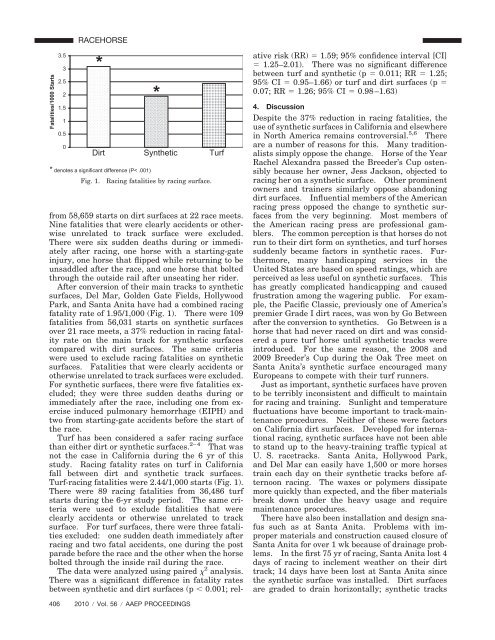Retired Racehorses
tfrr_reportandappendicesfinal
tfrr_reportandappendicesfinal
- No tags were found...
You also want an ePaper? Increase the reach of your titles
YUMPU automatically turns print PDFs into web optimized ePapers that Google loves.
Fatalities/1000 Starts<br />
3.5<br />
3<br />
2.5<br />
2<br />
1.5<br />
1<br />
0.5<br />
0<br />
RACEHORSE<br />
*<br />
Dirt Synthetic Turf<br />
* denotes a significant difference (P< .001)<br />
Fig. 1. Racing fatalities by racing surface.<br />
from 58,659 starts on dirt surfaces at 22 race meets.<br />
Nine fatalities that were clearly accidents or otherwise<br />
unrelated to track surface were excluded.<br />
There were six sudden deaths during or immediately<br />
after racing, one horse with a starting-gate<br />
injury, one horse that flipped while returning to be<br />
unsaddled after the race, and one horse that bolted<br />
through the outside rail after unseating her rider.<br />
After conversion of their main tracks to synthetic<br />
surfaces, Del Mar, Golden Gate Fields, Hollywood<br />
Park, and Santa Anita have had a combined racing<br />
fatality rate of 1.95/1,000 (Fig. 1). There were 109<br />
fatalities from 56,031 starts on synthetic surfaces<br />
over 21 race meets, a 37% reduction in racing fatality<br />
rate on the main track for synthetic surfaces<br />
compared with dirt surfaces. The same criteria<br />
were used to exclude racing fatalities on synthetic<br />
surfaces. Fatalities that were clearly accidents or<br />
otherwise unrelated to track surfaces were excluded.<br />
For synthetic surfaces, there were five fatalities excluded;<br />
they were three sudden deaths during or<br />
immediately after the race, including one from exercise<br />
induced pulmonary hemorrhage (EIPH) and<br />
two from starting-gate accidents before the start of<br />
the race.<br />
Turf has been considered a safer racing surface<br />
than either dirt or synthetic surfaces. 2–4 That was<br />
not the case in California during the 6 yr of this<br />
study. Racing fatality rates on turf in California<br />
fall between dirt and synthetic track surfaces.<br />
Turf-racing fatalities were 2.44/1,000 starts (Fig. 1).<br />
There were 89 racing fatalities from 36,486 turf<br />
starts during the 6-yr study period. The same criteria<br />
were used to exclude fatalities that were<br />
clearly accidents or otherwise unrelated to track<br />
surface. For turf surfaces, there were three fatali-<br />
*<br />
ties excluded: one sudden death immediately after<br />
racing and two fatal accidents, one during the post<br />
parade before the race and the other when the horse<br />
bolted through the inside rail during the race.<br />
The data were analyzed using paired 2 analysis.<br />
There was a significant difference in fatality rates<br />
between synthetic and dirt surfaces (p 0.001; relative<br />
risk (RR) 1.59; 95% confidence interval [CI]<br />
1.25–2.01). There was no significant difference<br />
between turf and synthetic (p 0.011; RR 1.25;<br />
95% CI 0.95–1.66) or turf and dirt surfaces (p <br />
0.07; RR 1.26; 95% CI 0.98–1.63)<br />
4. Discussion<br />
Despite the 37% reduction in racing fatalities, the<br />
use of synthetic surfaces in California and elsewhere<br />
in North America remains controversial. 5,6 There<br />
are a number of reasons for this. Many traditionalists<br />
simply oppose the change. Horse of the Year<br />
Rachel Alexandra passed the Breeder’s Cup ostensibly<br />
because her owner, Jess Jackson, objected to<br />
racing her on a synthetic surface. Other prominent<br />
owners and trainers similarly oppose abandoning<br />
dirt surfaces. Influential members of the American<br />
racing press opposed the change to synthetic surfaces<br />
from the very beginning. Most members of<br />
the American racing press are professional gamblers.<br />
The common perception is that horses do not<br />
run to their dirt form on synthetics, and turf horses<br />
suddenly became factors in synthetic races. Furthermore,<br />
many handicapping services in the<br />
United States are based on speed ratings, which are<br />
perceived as less useful on synthetic surfaces. This<br />
has greatly complicated handicapping and caused<br />
frustration among the wagering public. For example,<br />
the Pacific Classic, previously one of America’s<br />
premier Grade I dirt races, was won by Go Between<br />
after the conversion to synthetics. Go Between is a<br />
horse that had never raced on dirt and was considered<br />
a pure turf horse until synthetic tracks were<br />
introduced. For the same reason, the 2008 and<br />
2009 Breeder’s Cup during the Oak Tree meet on<br />
Santa Anita’s synthetic surface encouraged many<br />
Europeans to compete with their turf runners.<br />
Just as important, synthetic surfaces have proven<br />
to be terribly inconsistent and difficult to maintain<br />
for racing and training. Sunlight and temperature<br />
fluctuations have become important to track-maintenance<br />
procedures. Neither of these were factors<br />
on California dirt surfaces. Developed for international<br />
racing, synthetic surfaces have not been able<br />
to stand up to the heavy-training traffic typical at<br />
U. S. racetracks. Santa Anita, Hollywood Park,<br />
and Del Mar can easily have 1,500 or more horses<br />
train each day on their synthetic tracks before afternoon<br />
racing. The waxes or polymers dissipate<br />
more quickly than expected, and the fiber materials<br />
break down under the heavy usage and require<br />
maintenance procedures.<br />
There have also been installation and design snafus<br />
such as at Santa Anita. Problems with improper<br />
materials and construction caused closure of<br />
Santa Anita for over 1 wk because of drainage problems.<br />
In the first 75 yr of racing, Santa Anita lost 4<br />
days of racing to inclement weather on their dirt<br />
track; 14 days have been lost at Santa Anita since<br />
the synthetic surface was installed. Dirt surfaces<br />
are graded to drain horizontally; synthetic tracks<br />
406 2010 Vol. 56 AAEP PROCEEDINGS


